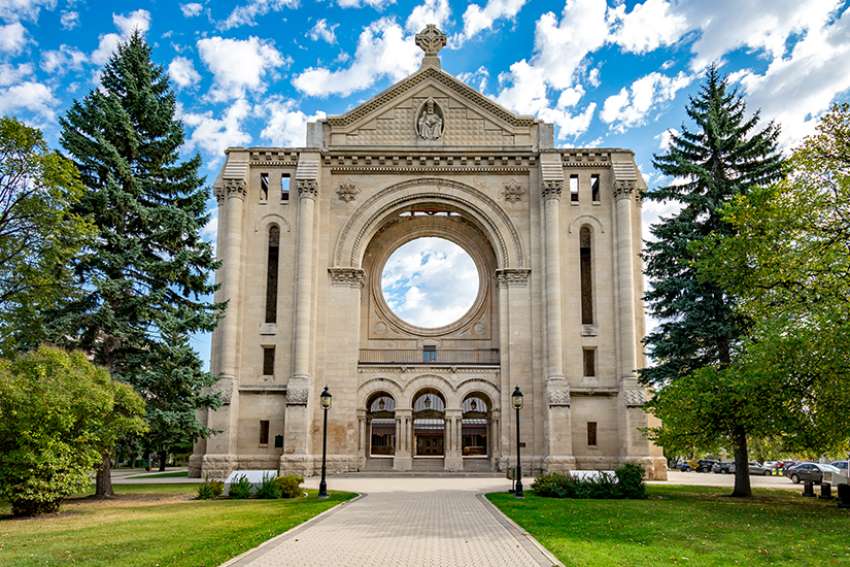Cardinal Gerald Lacroix, special envoy of Pope Francis, delivered a stirring call to evangelization. It was all the more bold for being delivered at the very site that physically marks the end of the old evangelization in Canada, and even now stands as a sign that the new evangelization may not take hold.
In Canadian Catholic history Winnipeg 1968 is remembered for that year’s plenary meeting of the Canadian bishops, who collectively sought to put as much distance as they could manage between themselves and Blessed Paul VI’s Humanae Vitae. But earlier that summer another catastrophe was suffered in the city, when a great fire consumed the St. Boniface Cathedral on July 22, leaving only the walls standing amidst charred ruins.
The cathedral, built in 1906, was a monument to the first evangelization of the Canadian West, conducted by French missionaries and built largely upon immigrants who brought their faith with them from the old continent. It was an impressive edifice, the grandest building in the city, a short walk from the Forks, the historic and contemporary centre of Winnipeg. When it burned, brave words were spoken about rebuilding it.
But soon boldness disappeared, and the decision was taken to leave the ruins as is, and rebuild within the old stone walls a new cathedral, much smaller, obscured in the shadows of the first building, a glass and steel fabrication that squatted rather than soared.
Devoid of beauty, it lacks the confidence of the previous Catholic community. The 1906 cathedral drew the attention of the entire community to the place of God in their midst. Its replacement points instead to an absence. Western Canada is not short of sacred architecture which is literally uninspiring, stifling the spirit. But the juxtaposition at St. Boniface of what is with what used to be makes it perhaps the saddest church to visit in Canada.
Catholica 200 was heavy on history, with the current Archbishop of St. Boniface, Albert LeGatt, arriving for the ceremonies by canoe in period costume. The cathedral site itself, literally a preserved ruin, speaks of a vibrant past. So it was necessary that Cardinal Lacroix directed attention to the future, summoning the assembly to evangelize. While preaching he could see the historic cemetery on the cathedral grounds before him. Behind him was the cathedral itself, a monumental gravestone marking the death of the first evangelization.
Cathedral Video - English version FINAL from Paroisse Cathédrale St-Boniface on Vimeo.
Will Cardinal Lacroix’s call be heeded? On the website of the St. Boniface Cathedral, there is a promotional video about how the cathedral ought to be part of a revitalized downtown core, a historic building “open to the world.” There is an assemblage of respectable Winnipeg society speaking of the heritage of the cathedral, and how it is proximate to the Canadian Museum of Human Rights, a new temple for a new age.
It takes great pains to include every possible potential visitor, including a hijab-wearing Muslim woman who waxes appreciative about hearing her son intone, for Earth Day, the Muslim call to prayer in the historic cathedral. Not exactly evangelization, old or new, but it was a rare mention of prayer or God in the video, so give credit to the Muslims for recognizing that it was a sacred building.
“Open to the world.” But why would the world come? What will they find? No indication that it might be Christ and His Church from the cathedral’s welcoming video.
By the time of the 1968 fire, whatever energy was left in French Catholicism in Canada was reduced to long-smoldering embers, at home in Quebec or across the vast mission lands of the West and North. The Quiet Revolution had already consumed the Church in Quebec, where even now the churches remain standing, not gravestones like St. Boniface, but mausoleums in which dead congregations are entombed.
Cardinal Lacroix knows that Quebec well, which is why as a young man he joined an institute dedicated to evangelization. That’s why he said the bicentennial “cannot remain a review of the past.”
From the necropolis that is the cathedral precinct of St. Boniface, he called for a new missionary mandate that is as valid today as it was in 1818 when the first missionaries arrived. The question for Catholica 200 is whether there are missionaries present now.
(Fr. de Souza is editor-in-chief of Convivium.ca and a pastor in the Archdiocese of Kingston.)


